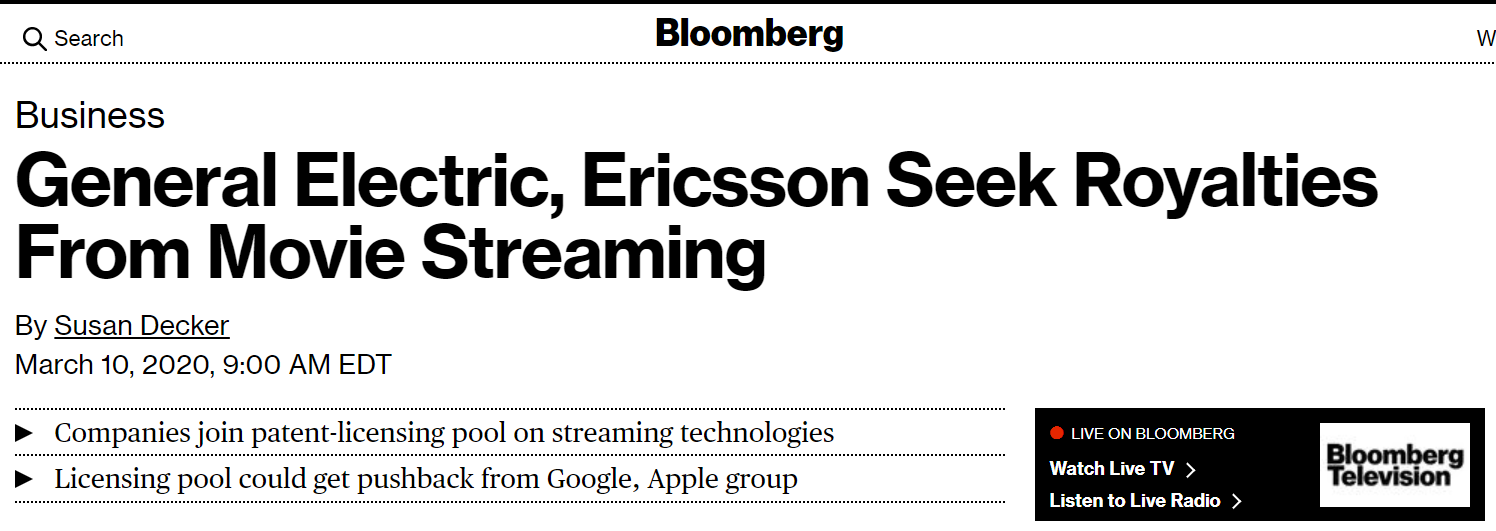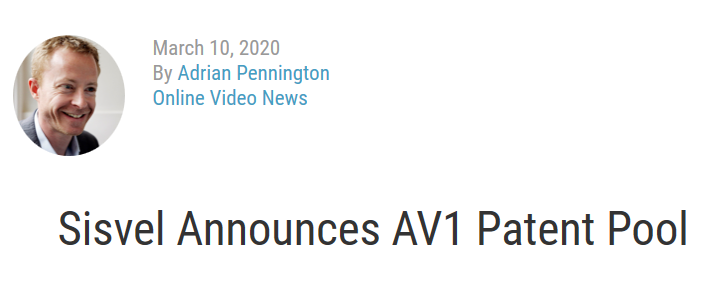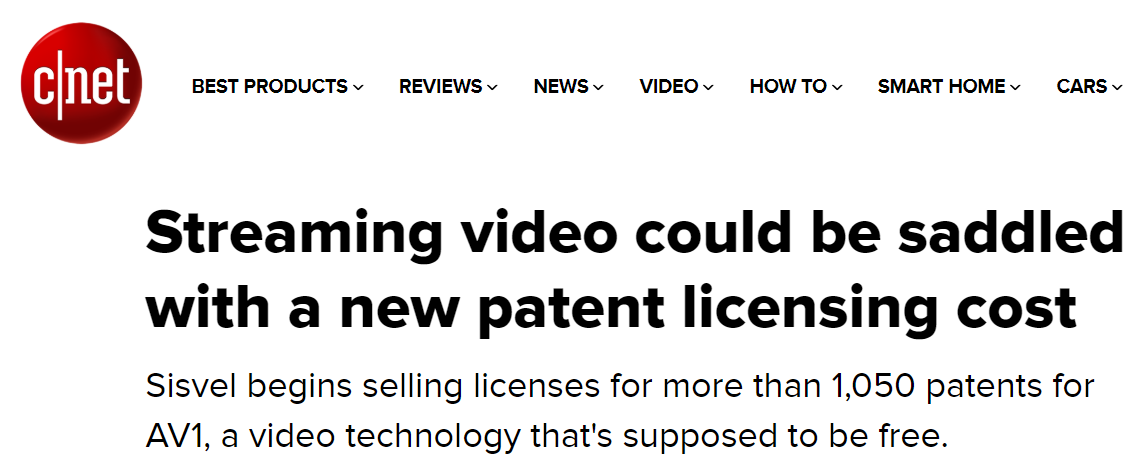Sisvel VP9/AV1 pools re-launch and editorial response
On March 10, Sisvel re-launched the AV1 and VP9 patent pools, adding nine new members and releasing initial patent lists for both pools. You can access the press release here. This blog post lists the news coverage relating to this announcement, with quotes and comments about each article.
Bloomberg, Susan Decker, March 10, 2020 (subscription may be required)
Ms. Decker is the patent reporter for Bloomberg News in Washington. As the headline suggests, Ms. Decker initially focused on the new members and reported that the pool brought “together hundreds of patents owned by a dozen companies as a “one-stop-shop” for companies that use the VP9 and AV1 video coding formats” citing Sisvel sources.
In a nod to the contributions of non-practicing entities, Ms. Decker also noted that “The pool members, which also include Dolby Laboratories Inc. and InterDigital Inc., are tech companies that have been contributing to the growth of the streaming industry but have no other way to recoup their investments than royalties on patents because they don’t make money directly from products.” Ms. Decker did note that “the new pool could face pushback from the companies that developed the two formats, including Alphabet Inc.’s Google.”
Streaming Media Magazine, Adrian Pennington, March 10, 2020
Mr. Pennington is a freelance writer who has written about AV1 and the Sisvel previously at IBC.org (login required). His overview positions the pool, which he reported should “reach a total portfolio offered for license of around 1,000 patents for VP9 and nearly 2,000 for AV1,” against AOMedia, which is “supported by companies either controlling huge ecosystems or developing chips that are used by hundreds of millions of customers worldwide.”
Quoting Sisvel CEO Mattia Fogliacco, Mr. Pennington also concisely frames the business and legal issue as follows: “AOMedia member companies have a good reason to offer their technology in AV1 for free,” Fogliacco argues. “They sell chips, video cards, or devices so they make money to finance their R&D techniques in other ways. “The people we represent don’t have that outlet for their contribution to video coding technology and are seeking to obtain in the form of a licence and royalty.
“It boils down to the fact that many patent holders for VP9 and AV1 are not members of AOMedia and so did not make any pledge to make this technology royalty free.”
The article also delineates Sisvel’s position on what is licenseable, stating, “Sisvel will not seek royalties for encoded content and currently only hardware implementations are being licenced – but this could change.”
C|Net, Stephen Shankland, March 10, 2020
Mr. Shankland is a senior reporter for CNET who has written about AV1 and other codec-related stories. Essentially, Mr. Shankland positioned the debate as between “Open vs. Proprietary,” reporting that, “Fans of open sharing — such as those in the now dominant open-source software movement — benefit from cooperative development and free use of the resulting products. The proprietary realm, where technology only may be used after fulfilling copyright and patent license agreements, is more restrictive.”
As a result, the article has a narrow focus and doesn’t cover several essential goals and aspects of the VP9 and AV1 pools. It has been pray of misinterpretations in blogs, where AOMedia company members have been presented as virtuous do-gooders who want video to be free, and pool members as those who “think there needs to be a new toll on the streaming video road.” This characterization ignores the fact that Google and AOMedia, who are the only one designing VP9 and AV1, choose to use technology protected by the patents in the Sisvel pools without consultation or authorization, and unfairly presents Sisvel and the patent owners as the bad guys in this story.
No design choices made to include third parties IP, no infringement, no patent pool; if AV1 and VP9 infringe upon the patents in the pools, the patent owners have every right to charge royalties.
IAM, Joff Wild, March 10, 2020 (subscription required)
Mr. Wild is Editor-in-Chief of IAM, which the magazine presents as the world’s leading IP business media platform. He starts by concisely detailing the announcement, writing, “Dolby, ETRI, Ericsson, GE, InterDigital, IP Bridge, NTT Docomo, SK Telecom and Xylene have joined forces with JVCKENWOOD, NTT, Orange, Philips and Toshiba Business Expert Corporation, which were already members of the platform that launched in March 2019 and which comprises two licensing programmes: one for over 650 patents relevant to the VP9 coding format and the other for more than 1,050 rights covering AV1.”
Citing Mr. Fogliacco, Mr. Wild succinctly describes the opposing stances taken by the AOMedia and the patent owners in the Sisvel pools. “Businesses invest in R&D for many reasons, Fogliacco states. Members of the Alliance for Open Media, he argues, believe that their best route to monetisation is to build products and services that use the AV1 codec and then to charge for items such as operating systems, CPUs, graphics chips and SoCs, and computers and mobile devices, as well as services and content. On the other hand: “The members of the Sisvel pool believe the best way to monetise their deep investments is through licensing.”
Also citing Sisvel’s CEO, Wild details the due diligence supporting the patents included in the pools. “Two levels of technical due diligence were performed on the patents, he says: one was done by technical experts in Sisvel, who have many years’ experience of participating in video coding standardisation efforts; while the other was undertaken by independent, third party, professionally accredited evaluators. This was to guarantee a very strong level of scrutiny of the patents included in the programmes.”
World Intellectual Property Review Rory O’Neill, March 11, 2020 (login required)
Rory O’Neill is a journalist with WIPR who covers intellectual-property related matters. His story largely focused on the timing of Sisvel’s licensing efforts. On this, O’Neill reported that “Sisvel’s CEO Mattia Fogliacco says the platform will look to begin licensing negotiations with manufacturers in the next month…Fogliacco said he is confident that their offer is fair and accessible to the market. ‘I am sure that whoever looks at the licence offer we are putting on the table will see that it is intended to endorse adoption of the technology.’”
O’Neill, accurately reported that it was Google’s and AOMedia’s actions that resulted in the patent pools being formed, not Sisvel. “One of the worries I had, when we launched the platform, was that patent owners and Sisvel would be blamed for charging royalties,” Fogliacco told WIPR. “But we did not have any say in choosing which patented technologies are used in the VP9 and AV1 formats,” he added.
ibc.org, Adrian Pennington, March 10, 2020
Another, more general article on codecs by Mr. Pennington, where he accurately summarizes how the pool announcement impacts Google and AOM, and how the pools can benefit the codec market. On the first point, Mr. Pennington reports, “Sisvel has published a list of additional patents – more than 650 for VP9 and 1,000 for AV1 – and expects to reach a total of around 1000 patents for VP9 and nearly 2000 for AV1. That means that the AOM either needs to concede licence terms with Sisvel or contest Sisvel’s pool claims – a process which at best could delay implementation of AV1 and at worst lead to huge legal expense and the internecine wranglings which beset HEVC.”
On the potential benefit to the market, Mr. Pennington shares, “Our goal with these pools is to reduce the friction in the market,” says Sisvel chief executive Mattia Fogliacco. “We believe pools create efficiency by enabling potential implementors to sign one agreement licensing multiple patent portfolios in one transaction at a reasonable and transparent cost.”






